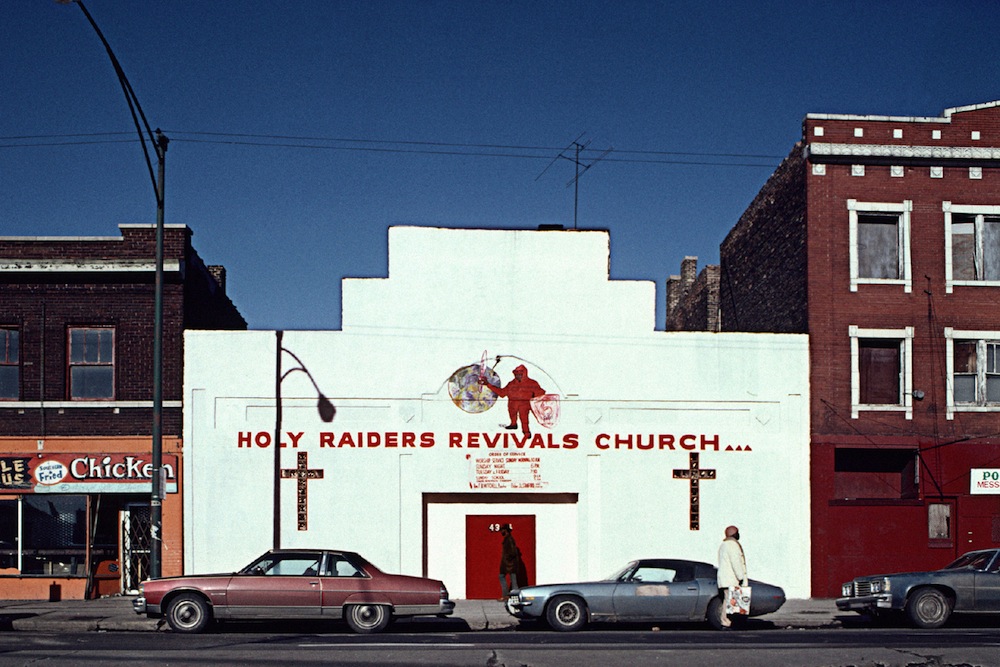Per circa quaranta anni Camilo José Vergara ha documentato le aree urbane disagiate degli Stati Uniti attraverso un meticoloso approccio documentale, in cui ha fotografato gli stessi edifici o aree ad intervalli di tempo regolari, riprendendone il decadimento e I cambi d’uso.
Praticamente estraneo al mercato della fotografia, Vergara ha ricevuto il supporto e l’attenzione di singoli ed istituzioni che si occupano del cambiamento e degli stravolgimenti urbani dell’America contemporanea.
Negli ultimi 15 anni la topologia visiva delle città si è decisamente ampliata, frammentata e disomogenea: da un lato sembra delegata a sistemi automatizzati come le videocamere di sorveglianza o Google Street View, oppure ritagliata e filtrata dagli smartphone e dai social network, oppure ancora restituita “soggettivamente” attraverso la lente del fotografo fine-art, con risultati variabili – dal patinato al reportage.
Vergara dice che egli stesso usa Google Maps e Street View nel suo lavoro di localizzazione, ma il risultato visivo e documentale che viene ne fuori ha un obiettivo diverso.
In questo contesto, il suo lavoro colma un vuoto metodologico – e paradossalmente anche estetico – riportando la rappresentazione della città alle sue funzioni base: abitare, lavorare, spostarsi. Gli edifici, protagonisti indiscussi di “Tracking Time”, hanno una vita urbana solo se le funzioni sopracitate sono ancora attive: venuta a mancare la funzione, le immagini raccontano il decadimento o la riconversione dell’edificio stesso. Allo stesso modo, le persone sono spesso presenti ma in maniera assolutamente casuale, a seconda dell’ora del giorno o della notte, e la loro interazione o meno con il luogo è parte del racconto. La luce stessa è parte del racconto, donando ad alcuni scatti una impronta particolarissima, pur sempre all’interno del minimalismo operativo che lo caratterizza.
Perfettamente integrato nella sua formazione di sociologo e urbanista, il progetto “Tracking Time” ha la sua anima nella fondamentale scansione del tempo, creando un corpus unico nel suo genere, fondamentale per capire l’America contemporanea.
Camilo José Vergara ha ricevuto numerosi riconoscimenti istituzionali negli Stati Uniti, non ultima la National Umanities Medal, conferitagli dal presidente Obama.
Gabriele Magazzù
- ENGLISH VERSION
For almost 40 years Camilo José Vergara has been documenting the impoverished urban areas of the US through a meticulous documentary approach. He’s shot the same buildings and areas at regular intervals, depicting the growing decay and change of destination.
Practically estranged from the photography market, Vergara has received support and attention from individual patrons and institutions operating in the fields of evolution and urban reconversion of contemporary America.
Over the past 15 years the visual topology of cities has been definitely expanded and fragmented, thus becoming uneven: on the one hand, it seems to be delegated to such automatised systems as surveillance cameras or Google Street View, cut out and filtered through smartphones and social networks, or even left to the subjective lens of fine-art photographers - with quite variable outcomes ranging from glossy to reportage-like style.
Vergara himself uses Google Maps and Street View for his localization work - obviously with a different visual and documental value.
In such a context, his work fills a methodological - and, paradoxically, aesthetic - void, bringing back the representation of cities to its former aims: inhabiting, working and moving. The buildings - undisputed protagonists of “Tracking Time” - have a urban existence only if the above-mentioned functions are still active: once the function ceases to be, images tell the story of decay or reconversion of the building itself. Similarly, people are often present, yet in an absolutely casual manner (according to day or night time), and their interaction (or lack of it) with the location becomes part of the story, too. Light itself is part of the story, conferring an extremely peculiar imprint to photographs within the constant operative minimalism that characterises them.
Perfectly fitting to the author's sociological and urbanist formation, “Tracking Time” finds its soul in the unavoidable monitoring of time, thus creating a unique result in its genre - a fundamental milestone to really comprehend contemporary America.
Camilo José Vergara has been awarded numerous institutional awards in the US - such as the National Humanities Medal he has recently been presented with by President Obama.
Please email us at info@phom.it.


Leave a Reply